Column: A bike tour reveals hidden Latino history in downtown Los Angeles
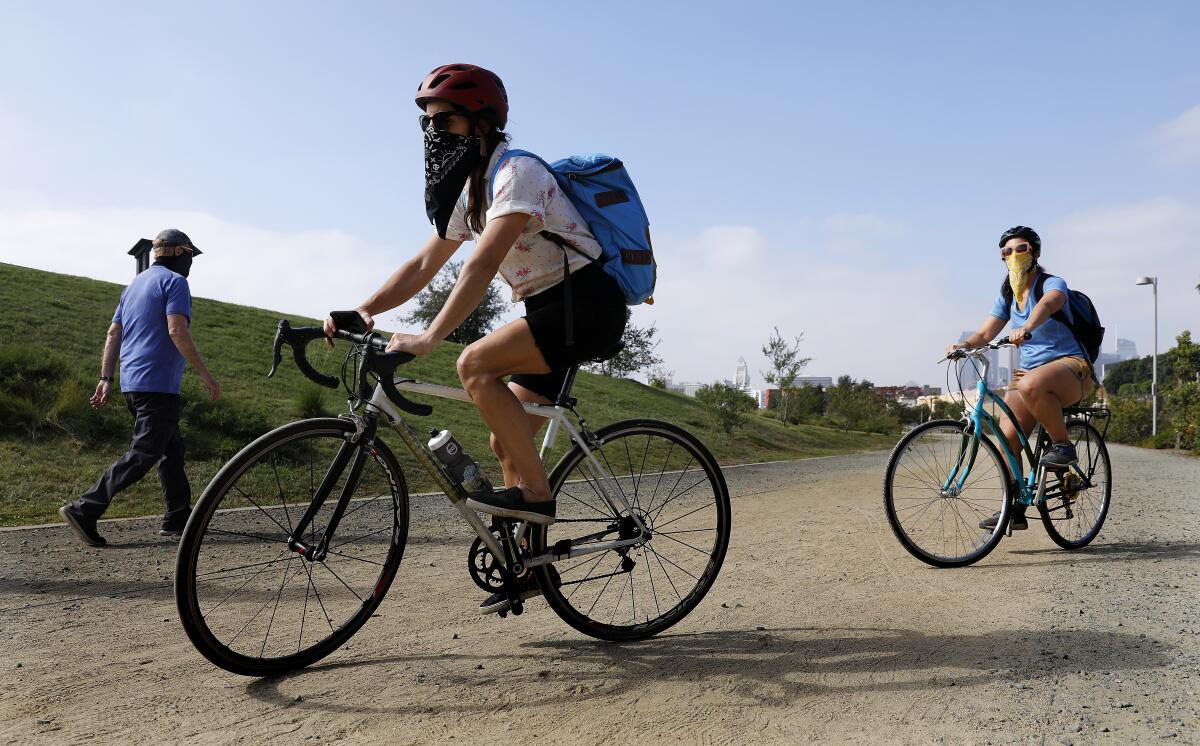
The distance was just over a quarter of a mile. On First Street, from the old Los Angeles Times building on Spring up to The Music Center on Grand. With a slight incline. Me and a Metro bike, ready to channel my inner Tour de France champ.
Perhaps be one of those Basques cyclists who dominate those mountain climbs.
I nearly died.
I hadnât biked more than a block in over a decade, yet I was already halfway through a six-mile bike ride around downtown Los Angeles that doubled as a history lesson on the forgotten past of Latinos in downtown. My lungs burned; my legs chafed.
Maybe I shouldâve worn a more appropriate outfit than a free T-shirt, baggy Dickies shorts that went past my knees, and leather huaraches with tire-tread soles.
But no way would I quit in front of my guide.
So I huffed and I puffed and I never once used the curb as a crutch. I was going to conquer this slight summit, dammit.
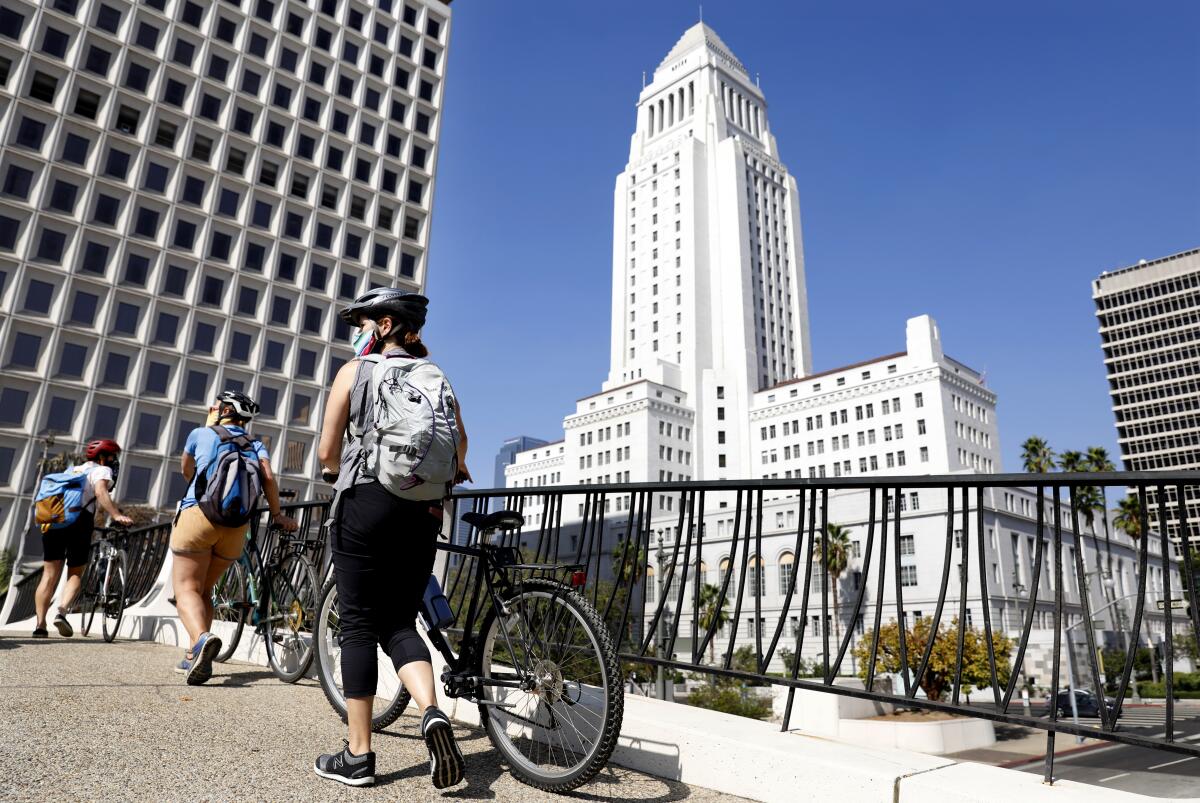
Next to me was UCLA Chicano Studies professor Marissa LĂłpez. She runs Picturing Mexican America, an Instagram account that tells the hidden histories of Latino Los Angeles through photos and copious captions. LĂłpez plans to eventually release a map-based app version of the project, but the avid cyclist worked with the Los Angeles Explorers Club to turn it into a 70-minute self-guided audio bike tour in the meantime.
I was her first guest.
And I was about to embark on something like a nerdy, violence-free version of âGrand Theft Auto V.â
Soon, we â OK, I â were catching our breath in front of The Music Center. Around us were the surnames of Old Los Angeles: Chandler. Taper. Ahmanson.
Wheezing for air, I asked LĂłpez why young people now seem so taken with woke history.
âItâs more about being accurate than woke,â she countered. âItâs important for young people to realize theyâre not interlopers. This is their city.â
A bikeable city, even for weaklings like me.
::
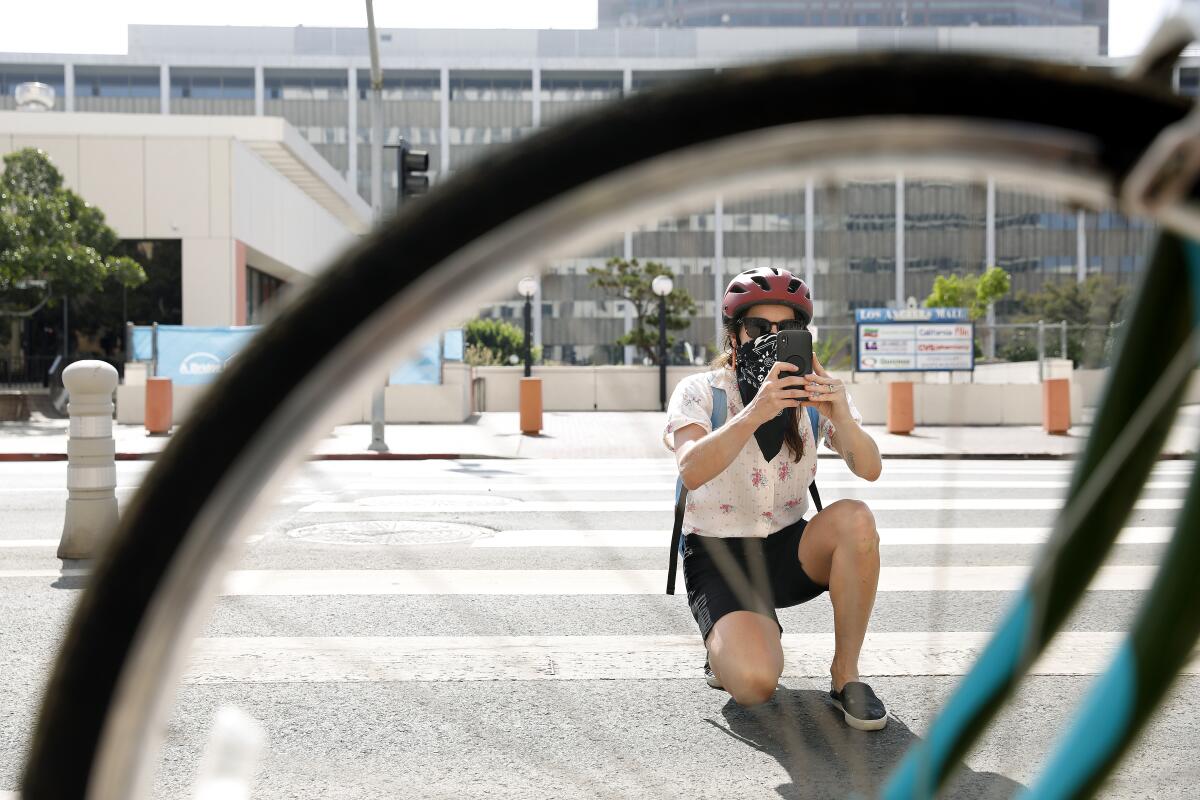
LĂłpez, Picturing Mexican America contributor Yvonne Condes and Explorers Club founder Aimee Gilchrist met me at Union Stationâs Metro Bike Share depot. They smiled when I confessed the date of my last ride â and now they wanted me to cycle from Olvera Street to City Hall all the way to Exposition Park and learn some radical Angeleno history along the way?
Couldnât I just Google it?
âBeing on a bike slows the world down,â LĂłpez assured me. âAll your senses have to be on, which allows you to absorb more.â
So off we went â they on fancy Electra, and Bianchi bikes, me on a sturdy, taxpayer-supported spoked steed.
Reckonings with our complicated past have swept across the country this year, and not just among the progressive set. Gilchrist, whose group focuses mostly on lighthearted bike rides that deal with Hollywood, Route 66, and L.A. noir, reached out to LĂłpez this spring to suggest the two create a downtown jaunt that was more than âthe whitewashing that usually happens on these things.â
LĂłpez and Condes wrote a script and uploaded a recording of it to Spotify; Gilchrist plotted out the route.
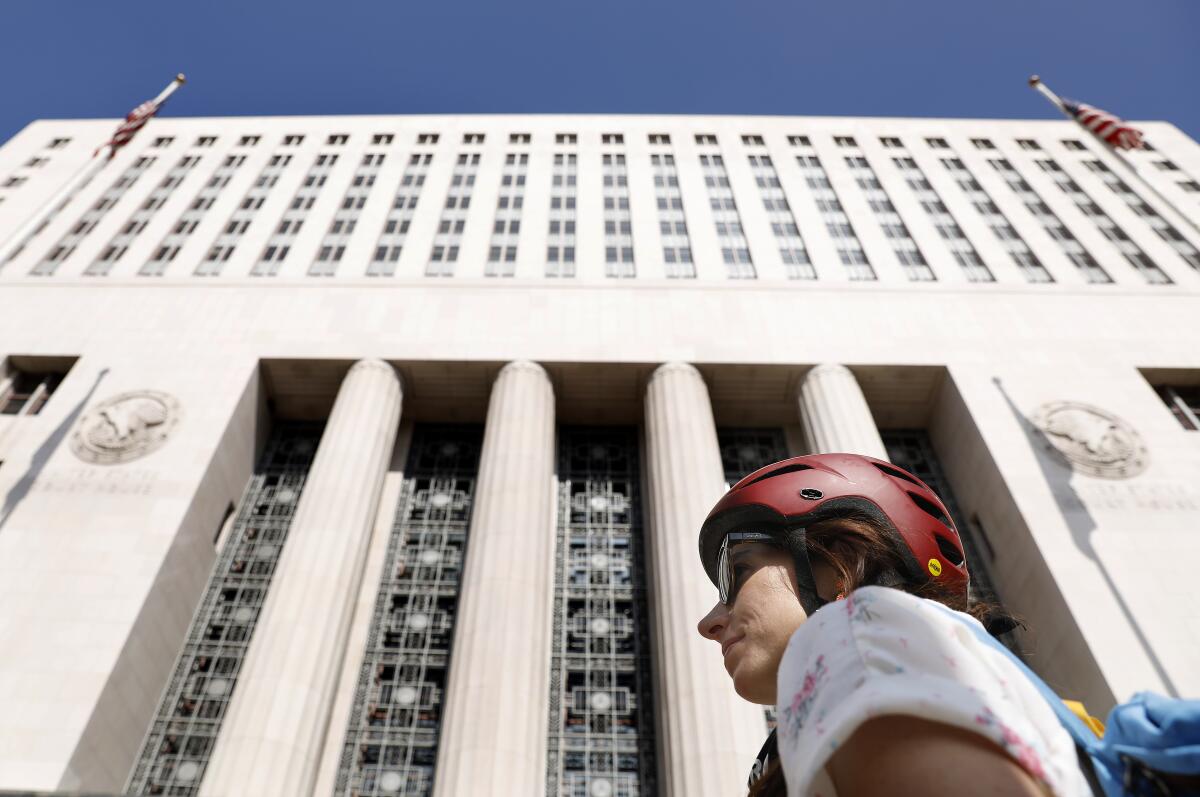
âThe industry of L.A. history is romanticizing, erasing, and promoting a white gaze,â LĂłpez said as we pedaled up Alameda toward Los Angeles State Historic Park. âBut something like this is about all the stuff left out. You learn to love L.A. more.â
Our first stop: The Zanja Madre, the cityâs first aqueduct. A handmade sign on a fence pointed out a stretch of a brick-encased ditch that ran parallel to the Gold Line tracks. Thatâs how L.A.âs founders first brought water to the parched town.
The audio version of LĂłpezâs tour is comprehensive, if too earnest. In person, her delivery is insightful and droll.
âHistorians always call this L.A.âs original public works project,â LĂłpez said. âBut they never talked about the forced Indigenous labor that made it happen. Instead, they make it seem like one giant, consensual fiesta.â
We circled around the park, and the profe was right: I noticed far more than I would have on foot or car. The city unveiled itself. On a hill was St. Peterâs Italian Church. In the shade were volunteers handing out free food. Joggers and other cyclists buzzed around. Looming over the scene was the L.A. skyline.
LĂłpez made a Spotify soundtrack complete with chipster â thatâs Chicano hipsters, people â favorites Chicano Batman, Ozomatli and Las Cafeteras for people who wanted to take the tour sans her narration.
Next up was Fletcher Bowron Square, named after the mayor who guided Los Angeles from the end of the Great Depression through World War II and into the 1950s. There was nothing on the tan concrete walls that bore Bowronâs name about who he was, but a plaque identified the site as the location for the cityâs first newspaper, the Los Angeles Star.
LĂłpez looked like Mookie Betts ready to swing at a fourth-graderâs fastball.
âSo no mention that Bowron was one of the biggest advocates to round up Japanese Americans during World War II,â she said. âNo mention that the Star published bilingually in its early years. No mention that across the street was a market where Native Americans were essentially sold as slave labor.â
She waited a beat.
âYou have to work hard to make this place boring.â
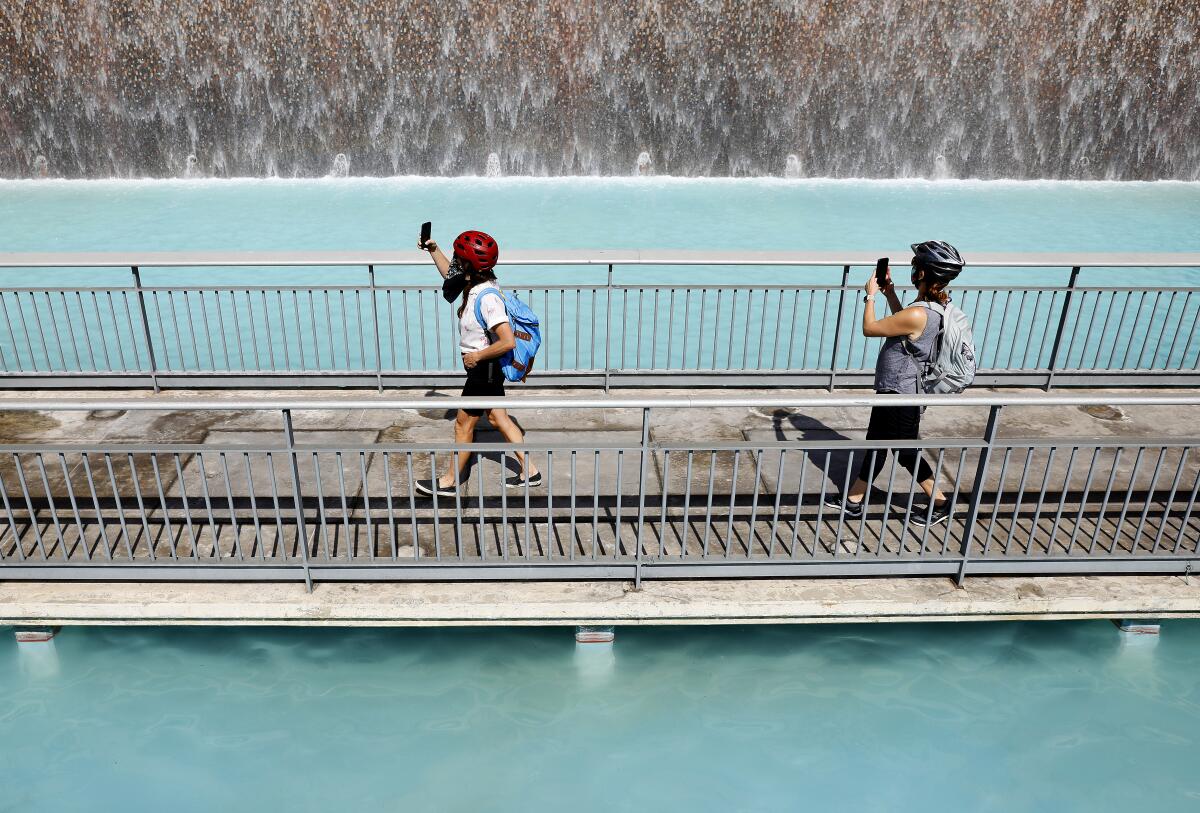
Condes kept us on schedule. We walked our bikes past a Millard Sheets mural on City Hall East, then sped past the former headquarters of The Times before taking on that brutal incline up First Street. LĂłpez, Condes, and Gilchrist reached the summit with ease.
A downhill path thankfully followed to the highlight of the tour: The Fort Moore Pioneer Memorial. An 80-foot-long waterfall cascaded into a shallow pool that Mayor Eric Garcetti should turn into a mini-Raging Waters. Towering over us were the largest bas relief military monuments in the United States.
Captions proclaimed the glories of âthe troops who helped to win the Southwestâ and the âsettlers who made Los Angeles a cityâ â never mind that Mexicans founded Los Angeles in 1781.
âItâs an awe-inspiring, unironic monument to U.S. colonialism,â LĂłpez said dryly.
âThis is gross,â Gilchrist cracked.
Condes pointed out a smaller plaque. Lost among a dogpile of etched names was that of Daisuke âDikeâ Nagano, a pioneering Japanese American architect who designed the Fort Moore monument.
âJust a decade before he did this, he was in an internment camp,â she said.
LĂłpez didnât even get into how whites regularly lynched Mexicans here â because I already knew that part, at least.
My guides wanted to push to Exposition Park, but my calves declined the invite. So we zipped through Chinatown before ending up in Olvera Street, long derided as a fake tourist trap and not spared a ding in LĂłpezâs script.
Before us was something else: Latinos eating, shopping, and even posing on the areaâs infamous burro while wearing ponchos and bandoliers. Business was finally returning to the shopping district after months of coronavirus-caused shutdowns.
âPeople make history real,â LĂłpez said. âPeople make it their own. We have to move forward together to make a better tomorrow.â
She doesnât plan to offer any group rides until the coronavirus crisis is over, but you donât need to wait that long. Visit the Los Angeles Explorer Clubâs website, download the route and audio guide, and learn a better, fuller history about L.A. than whatever you learned back in high school.
But, just in case, make sure to work out those calves.
More to Read
Sign up for Essential California
The most important California stories and recommendations in your inbox every morning.
You may occasionally receive promotional content from the Los Angeles Times.











